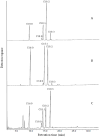Impact of Plant Oil Supplementation on Lipid Production and Fatty Acid Composition in Cunninghamella elegans TISTR 3370
- PMID: 38792821
- PMCID: PMC11124419
- DOI: 10.3390/microorganisms12050992
Impact of Plant Oil Supplementation on Lipid Production and Fatty Acid Composition in Cunninghamella elegans TISTR 3370
Abstract
The Cunninghamella genus has been utilized for the production of PUFA-rich lipids. Therefore, we investigate the impact of plant oil supplementation in the culture medium (soybean oil, rice bran oil, and perilla oil), selected based on their different fatty acid predominant, on lipid production and fatty acid composition in C. elegans (TISTR 3370). All oils significantly boosted fungal growth, each influencing distinct patterns of lipid accumulation within the cells. The cells exhibited distinct patterns of lipid accumulation, forming intracellular lipid bodies, influenced by the different oils. Monounsaturated fatty acids (MUFAs) were found to be the most abundant, followed by polyunsaturated fatty acids (PUFAs) and saturated fatty acids (SFAs) in the fungal lipid cultures. Oleic acid was identified as the primary MUFA, while palmitic acid was the predominant SFA in perilla oil supplements. Remarkably, perilla oil supplement provided the highest total lipid production with arachidonic acid being exclusively detected. The percentage of PUFAs ranged from 12% in the control to 33% in soybean oil, 32% in rice bran oil, and 61% in perilla oil supplements. These findings offer valuable opportunities for advancing biotechnological applications in lipid production and customization, with implications for food and nutrition as well as pharmaceuticals and cosmetics.
Keywords: fungi; perilla oil; rice bran oil; soybean oil; unsaturated fatty acids.
Conflict of interest statement
The authors declare no conflicts of interest.
Figures


References
LinkOut - more resources
Full Text Sources

